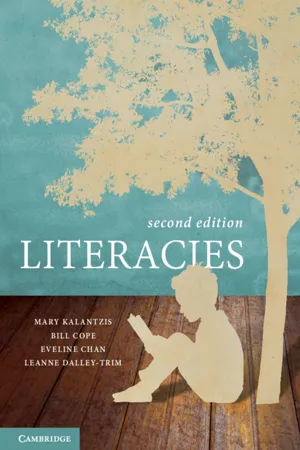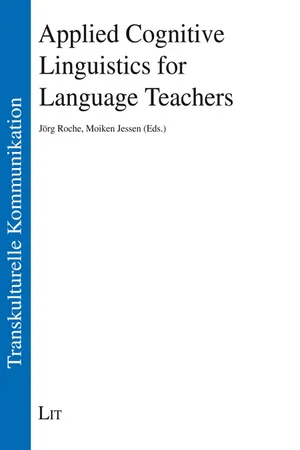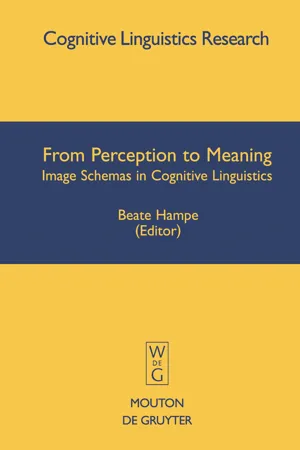Languages & Linguistics
Tactile Imagery
Tactile imagery refers to the use of language to create a sensory experience of touch for the reader or listener. It is a type of imagery that appeals to the sense of touch and can be used to evoke emotions or create a vivid description of a scene or object. Tactile imagery is commonly used in literature and poetry to enhance the reader's experience.
Written by Perlego with AI-assistance
Related key terms
1 of 5
3 Key excerpts on "Tactile Imagery"
- eBook - PDF
- Mary Kalantzis, Bill Cope, Eveline Chan, Leanne Dalley-Trim(Authors)
- 2016(Publication Date)
- Cambridge University Press(Publisher)
We start meaning these foundational things in tactile, gestural and spatial ways, and keep meaning them in these ways for the rest of our lives. The main thing that language adds to tactile meaning after the age of about 18 months is to support a kind of conscious reflexivity that is only found in human communication and cognition. More than that, this conscious reflexivity comes to the other modes of meaning at the same time as language. It is not unique to language. Conversely, language in its humanly meaningful entirety can be represented and communicated through touch, for instance with Braille. Figure 12.4 Braille Braille: A tactile form of writing for those who are sight-impaired 382 Part C: The ‘what’ of literacies Tactile representation and communication involve direct bodily engagement with the material world. (Vision and hearing, by comparison, are engagements at a distance.) To illustrate how this happens, we will focus on the tactile meaning of objects. We’re not interested in the objects alone, but also in the meanings we make of the objects. We live with distinguishable things, which we sometimes pick up, feel, hand to someone or locate in a position. We use objects: wearing shoes, driving a car, cutting with a knife, putting food in our mouths. We do things with objects and this doing makes us who we are – an avid walker, a terrible driver or a good cook. We can create mental anticipations of the use of objects in our mind’s eye or modelled on the templates of cultural tradition (tactile representations): how I will use this kitchen implement, how I will handle the ball in this game, how I will put on this item of clothing, how I will use a pen or a brush to create a picture. - Jorg Roche, Moiken Jessen(Authors)
- 2023(Publication Date)
- LIT Verlag(Publisher)
95 3 Linguistic Imagery It is astounding to see how important the role of images is in our mind. Not only in terms of modern media (visual turn) but also in the realm of lan- guage. As imagery in language is so prevalent in everyday lives the present chapter will concentrate solely on language imagery and its special role in cognition and language acquisition. To illustrate the prevalence of images in language, let us look at a couple of expressions such as to solve a prob- lem or to break someone’s heart. If we took the expressions at face value, we would have to expect a chemical experiment on an issue (in the sense of the dissolution of something in an acidic solution) or a physical assault on someone’s heart. In the first part of the chapter, we will explore how such metaphors and metonymies work and how traditional linguistics describes and explains these phenomena. Subsequently, we will discuss cognitive mechanisms fundamental to the ubiquitous imagery use in language We will also elab- orate on metonymy, a linguistic element quite similar to metaphor. The conceptual metaphor theory will be presented and compared with the tra- ditional (literary) perspective on metaphors. We will touch on the concep- tual metaphor’s ability to represent mappings between cultural domains, and we will address the role of imagery for the way we think. It will be shown how abstract concepts can be understood through images. Finally, we will explore the role of imagery with respect to the processes of knowledge construction, knowledge representation and knowledge storage in a learner’s mind. 96 3.1 Linguistic Imagery and the Conceptual Metaphor Natalya Furashova, Moiken Jessen & Katsiaryna EL-Bouz Sometimes, people are not straightforward with what they mean to say, and – on the other hand – words are not always used to express their literal meaning. We could, for instance, say about a person that he is cun- ning or clever.- eBook - PDF
From Perception to Meaning
Image Schemas in Cognitive Linguistics
- Beate Hampe(Author)
- 2008(Publication Date)
- De Gruyter Mouton(Publisher)
The phenomenon of verbal synaesthesia, which reflects linguisti-cally some of the cross-modal transfers of properties characteristic of percep-tual synaesthesia, provides the case study material for testing this claim. An examination of this verbal phenomenon reveals the dominance of touch as a source domain in synaesthetic mappings, a fact that despite being widely documented and studied remains unexplained. By relating the linguistic analysis of synaesthetic adjective-noun pairs to what is known about percep-tual synaesthesia and tactile perception, this chapter aims (i) to elucidate the prevalent patterns of transfer to be found in verbal synaesthesia, and (ii) to establish the relevance of tactile experience to the SCALE image schema. It will thus also (iii) contribute to the debate about the abstract (modality-independent) versus perceptual nature of image schemas. 2. Synaesthesia in perception and language Synaesthesia (from the Greek syn ÿtogetherþ and aisthesia ÿperceptionþ) is the involuntary perceptual experience of a cross-modal association. In psycho-logical and neuro-psychological terms this means that the stimulation of one sensory modality reliably and invariably (for a particular person) causes a perception in one or more different senses. This ýjoined sensationü manifests 1. Cienki (1998) is an exception in that he discusses the specific contribution o f haptics (understood as manipulation of objects) for the experiential grounding of another image schema that he proposes, namely STRAIGHT . Image schemas and verbal synaesthesia 397 itself as the capacity in some people to hear colours (the most common type), taste shapes, feel sounds or experience other, equally startling sensory blend-ings. The condition is rare, idiosyncratic and perma nent: peopleþs particular connections between the senses are unique to them and remain unchanged throughout their lives (cf. Cytowic 1989, 1994).
Index pages curate the most relevant extracts from our library of academic textbooks. They’ve been created using an in-house natural language model (NLM), each adding context and meaning to key research topics.


